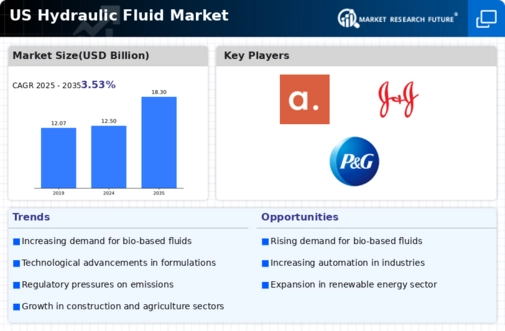The hydraulic fluid market is characterized by a competitive landscape that is increasingly shaped by innovation, sustainability, and strategic partnerships. Key players such as ExxonMobil (US), Chevron (US), and Parker Hannifin (US) are actively pursuing strategies that emphasize technological advancements and eco-friendly solutions. ExxonMobil (US) has been focusing on enhancing its product portfolio with bio-based hydraulic fluids, which aligns with the growing demand for sustainable alternatives. Meanwhile, Chevron (US) is investing in digital transformation initiatives to optimize its supply chain and improve operational efficiency, thereby reinforcing its market position. Collectively, these strategies indicate a shift towards a more sustainable and technologically advanced competitive environment.
In terms of business tactics, companies are increasingly localizing manufacturing to reduce lead times and enhance responsiveness to market demands. The competitive structure of the hydraulic fluid market appears moderately fragmented, with several key players exerting influence over various segments. This fragmentation allows for niche players to thrive, while larger corporations leverage their scale to optimize supply chains and innovate rapidly.
In November 2025, ExxonMobil (US) announced the launch of a new line of biodegradable hydraulic fluids designed for environmentally sensitive applications. This strategic move not only caters to the rising demand for sustainable products but also positions ExxonMobil (US) as a leader in eco-friendly solutions within the hydraulic fluid sector. The introduction of these fluids is likely to enhance customer loyalty and attract new clients who prioritize sustainability.
In October 2025, Chevron (US) unveiled a comprehensive digital platform aimed at streamlining its hydraulic fluid distribution network. This initiative is expected to significantly reduce operational costs and improve service delivery. By integrating advanced analytics and AI into its supply chain processes, Chevron (US) is poised to enhance its competitive edge, ensuring that it remains responsive to market fluctuations and customer needs.
In September 2025, Parker Hannifin (US) entered into a strategic partnership with a leading technology firm to develop smart hydraulic systems that utilize IoT capabilities. This collaboration is indicative of a broader trend towards the integration of digital technologies in hydraulic systems, which could lead to improved efficiency and predictive maintenance. Such innovations are likely to redefine operational standards in the industry, setting new benchmarks for performance and reliability.
As of December 2025, the hydraulic fluid market is witnessing trends that emphasize digitalization, sustainability, and the integration of AI technologies. Strategic alliances are becoming increasingly pivotal, as companies seek to leverage complementary strengths to enhance their market offerings. The competitive differentiation is expected to evolve from traditional price-based competition towards a focus on innovation, technological advancements, and supply chain reliability. This shift underscores the necessity for companies to adapt and innovate continuously to maintain relevance in a rapidly changing market.














Leave a Comment